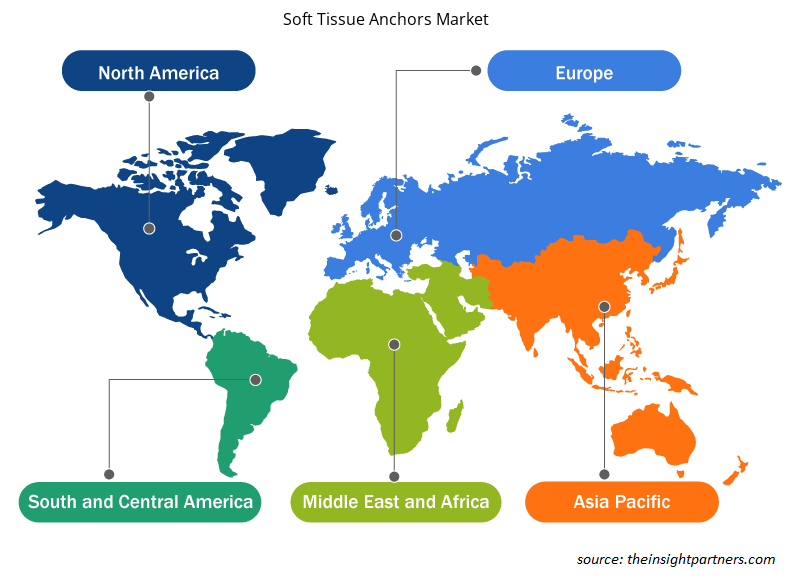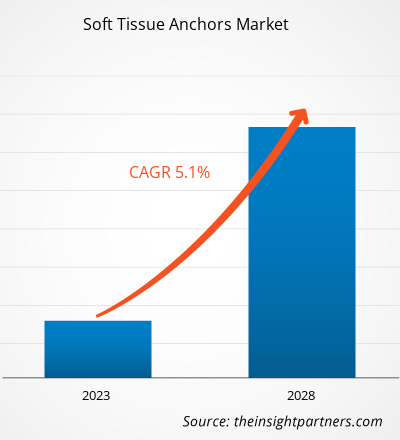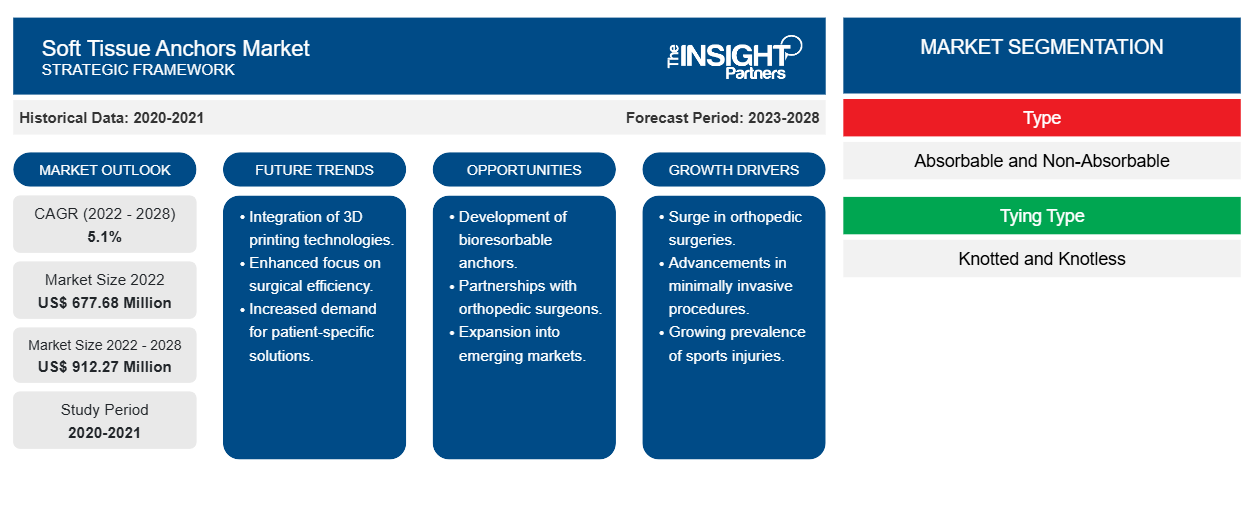Si prevede che il mercato degli ancoraggi per tessuti molli crescerà da 677,68 milioni di dollari nel 2022 a 912,27 milioni di dollari entro il 2028; si prevede che registrerà un CAGR del 5,1% dal 2022 al 2028.
Le ancore per tessuti molli sono dispositivi di fissaggio dei tessuti molli generalmente utilizzati negli interventi chirurgici ortopedici. Le fratture e le lesioni ossee ortopediche possono essere causate da vari motivi, come traumi acuti, sport e attività fisiche pesanti. Suture, ancore e viti di interferenza sono vari dispositivi di fissaggio utilizzati per il fissaggio dei tessuti molli. La lussazione della spalla è comune tra gli atleti e il metodo di riparazione artroscopica di Bankart che utilizza ancore per tessuti molli è il metodo più preferito per il trattamento della lussazione della spalla. L'aumento degli infortuni sportivi, degli interventi chirurgici ortopedici e il significativo aumento della popolazione geriatrica e obesa sono i fattori chiave che stanno guidando la crescita del mercato delle ancore per tessuti molli . Tuttavia, l'elevato costo degli interventi chirurgici e gli scenari di rimborso sfavorevoli stanno ostacolando la crescita del mercato.
Il rapporto offre approfondimenti e analisi approfondite del mercato degli ancoraggi per tessuti molli, sottolineando vari parametri come tendenze di mercato, progressi tecnologici, dinamiche di mercato e analisi del panorama competitivo dei principali attori del mercato globale. Include anche l'impatto della pandemia di COVID-19 sul mercato in tutte le regioni. Molte autorità sanitarie si sono concentrate sulle cure correlate alla pandemia di COVID-19. Hanno evitato il contatto umano a causa della crescente trasmissione e della pressione sulle risorse sanitarie posticipando interventi chirurgici elettivi, sospendendo ambulatori e selezionando i dipendenti coinvolti in cure urgenti. Inoltre, molti paesi hanno imposto restrizioni all'accesso del personale non clinico alla struttura e agli ospiti. I chirurghi ortopedici hanno sperimentato importanti effetti sulla loro capacità di offrire cure chirurgiche, formazione e ricerca tempestive e di alta qualità a causa di questi cambiamenti. Le recenti linee guida COVID-19 per i chirurghi ortopedici pediatrici hanno suggerito di concentrarsi sulle cure urgenti e sui casi di selezione per posticipare interventi chirurgici elettivi e appuntamenti in clinica, passando a cure basate su virtuale quando appropriato.
Personalizza questo report in base alle tue esigenze
Riceverai la personalizzazione gratuita di qualsiasi report, comprese parti di questo report, o analisi a livello nazionale, pacchetto dati Excel, oltre a usufruire di grandi offerte e sconti per start-up e università
-
Scopri le principali tendenze di mercato in questo rapporto.Questo campione GRATUITO includerà analisi di dati che spaziano dalle tendenze di mercato alle stime e alle previsioni.
Molte aziende che producono ancore per tessuti molli si concentrano sulla risposta alle emergenze tramite varie strategie, come la produzione di DPI per gli operatori sanitari e la distribuzione di farmaci. Ad esempio, a settembre 2020, Arthrex, leader mondiale nella tecnologia ortopedica minimamente invasiva, ha annunciato che sta utilizzando le sue capacità innovative per produrre e donare oltre 6.000 visiere protettive ai sistemi scolastici di tutta la regione. Allo stesso modo, l'azienda ha collaborato con professionisti medici, servizi di emergenza locali e amministratori sanitari per valutare le maggiori esigenze dei lavoratori essenziali che curano e interagiscono con pazienti infetti da SARS-CoV-2. Il progetto più significativo riguarda la produzione di visiere protettive e cappucci. Pertanto, la pandemia di COVID-19 ha ostacolato il mercato delle ancore per tessuti molli.
Il mercato degli ancoraggi per tessuti molli è segmentato in base a tipo, tipo di legatura, materiale, utente finale e area geografica. Per regione, il mercato è segmentato in Nord America, Europa, Asia Pacifico, Medio Oriente e Africa e Sud e Centro America.
Approfondimenti di mercato
Aumento degli infortuni sportivi e degli interventi chirurgici ortopedici
Gli sport hanno registrato una crescita enorme e una vasta popolazione sta optando per uno stile di vita attivo, aumentando le attività fisiche come la palestra e lo sport. Ciò ha portato a un aumento degli infortuni sportivi come lesioni alla cuffia dei rotatori, rotture dei legamenti e rotture dei tendini. Secondo il rapporto del Johns Hopkins Medicine, negli Stati Uniti vengono segnalati circa 3,5 milioni di infortuni sportivi all'anno. Secondo l'Hospital for Special Surgery, le lesioni alla cuffia dei rotatori sono molto comuni e colpiscono 2-4 milioni di persone negli Stati Uniti ogni anno. Le condizioni della cuffia dei rotatori si sviluppano nel tempo e sono molto comuni tra gli atleti e la popolazione geriatrica e possono causare traumi. Pertanto, si prevede che un aumento degli sport e delle attività fisiche creerà domanda di ancore per tessuti molli e contribuirà alla crescita del mercato.
La crescente popolazione geriatrica è altamente incline a varie condizioni ortopediche come disturbi articolari, lesioni del legamento crociato anteriore (LCA), fusione articolare, osteoartrite e altre. Secondo il Center Orthopedic & Neurosurgical Care & Research, entro il 2030, si prevede che gli interventi di sostituzione totale del ginocchio cresceranno del 673%, arrivando a 3,5 milioni di procedure all'anno. Ciò ha aumentato gli interventi di chirurgia ortopedica, il che crea la domanda di ancore per tessuti molli. Inoltre, la crescente domanda di procedure minimamente invasive ha aumentato gli interventi di chirurgia artroscopica grazie a vari vantaggi come un recupero più rapido e brevi ricoveri ospedalieri. Secondo la Harvard Medical School, l'artroscopia del ginocchio è uno degli interventi più comuni eseguiti su larga scala; ogni anno negli Stati Uniti vengono eseguite circa 750.000 operazioni artroscopiche al ginocchio, con un costo totale di 4 miliardi di dollari. Inoltre, si prevede che un aumento del numero di incidenti stradali e casi di trauma contribuirà a una quota importante degli interventi di chirurgia ortopedica. Secondo il Dipartimento dei trasporti degli Stati Uniti, ogni anno negli Stati Uniti si verificano oltre ~6 milioni di incidenti automobilistici. In Florida, oltre ~350.000 conducenti sono coinvolti in incidenti stradali, che causano 200.000 feriti ogni anno, tra cui lesioni alla colonna vertebrale, lesioni al ginocchio e altro.
Pertanto, l'elevato tasso di adozione di uno stile di vita attivo, l'aumento delle attività sportive e degli infortuni sportivi, l'aumento degli interventi di chirurgia ortopedica dovuto alla numerosa popolazione geriatrica e l'aumento dei casi di trauma stanno guidando la crescita del mercato degli ancoraggi per tessuti molli.
Informazioni basate sul tipo
In base al tipo, il mercato delle ancore per tessuti molli è diviso in assorbibili e non assorbibili. Nel 2022, il segmento assorbibile ha rappresentato una quota maggiore del mercato; si prevede che continuerà a dominare nel periodo di previsione. Le ancore per tessuti molli assorbibili sono ampiamente utilizzate in quanto vengono assorbite dal corpo e riducono le complicazioni mediche. Inoltre, si prevede che il segmento assorbibile registrerà il CAGR più elevato nel mercato delle ancore per tessuti molli dal 2022 al 2028.
- In base al tipo di tipizzazione, il mercato delle ancore per tessuti molli è diviso in annodate e senza nodi. Il segmento senza nodi ha detenuto una quota di mercato maggiore nel 2021 e si prevede che registrerà il CAGR più elevato durante il periodo di previsione.
- In base al materiale, il mercato delle ancore per tessuti molli è segmentato in ancore di sutura metalliche, ancore di sutura bioassorbibili, ancore di sutura in PEEK, ancore di sutura biocomposite e altre. Il segmento delle ancore di sutura in PEEK ha detenuto la quota maggiore del mercato nel 2022; tuttavia, si prevede che il segmento delle ancore di sutura biocomposite registrerà il CAGR più elevato del 5,7% nel mercato durante il periodo di previsione.
- In base all'applicazione, il mercato degli ancoraggi per tessuti molli è segmentato in gestione della salute, gestione della salute finanziaria, gestione della salute domiciliare e altri. Il segmento della gestione della salute ha detenuto la quota di mercato più grande nel 2022 e si prevede che registrerà il CAGR più elevato nel mercato durante il periodo di previsione.
- In base all'utente finale, il mercato degli ancoraggi per tessuti molli è segmentato in ospedali, cliniche, servizi medici di emergenza e altri. Il segmento degli ospedali ha detenuto la quota di mercato più grande nel 2022; tuttavia, si stima che il segmento dei servizi medici di emergenza registrerà il CAGR più alto del 5,7% nel mercato durante il periodo di previsione.
Gli operatori del mercato degli ancoraggi per tessuti molli adottano strategie organiche come il lancio e l'espansione del prodotto per espandere la propria presenza globale e il portafoglio prodotti e soddisfare la crescente domanda. A maggio 2022, Conmed ha acquisito In2Bones Global, Inc. (In2Bones) di proprietà privata, su base cash-free, debt-free, per un corrispettivo in contanti di 145 milioni di dollari USA alla chiusura e fino a un ulteriore 110 milioni di dollari USA in pagamenti di earn-out basati sulla crescita in quattro anni.
Approfondimenti basati sulla geografia
In base alla geografia, il mercato degli ancoraggi per tessuti molli è segmentato in Nord America (Stati Uniti, Canada e Messico), Europa (Francia, Germania, Regno Unito, Spagna, Italia e resto d'Europa), Asia Pacifico (Cina, India, Giappone, Australia, Corea del Sud e resto dell'APAC), Medio Oriente e Africa (Arabia Saudita, Emirati Arabi Uniti, Sudafrica e resto dell'area MEA) e Sud e Centro America (Brasile, Argentina e resto del Sud e Centro America).
Approfondimenti regionali sul mercato degli ancoraggi per tessuti molli
Le tendenze regionali e i fattori che influenzano il mercato degli ancoraggi per tessuti molli durante il periodo di previsione sono stati ampiamente spiegati dagli analisti di Insight Partners. Questa sezione discute anche i segmenti e la geografia del mercato degli ancoraggi per tessuti molli in Nord America, Europa, Asia Pacifico, Medio Oriente e Africa e America centrale e meridionale.

- Ottieni i dati specifici regionali per il mercato degli ancoraggi per tessuti molli
Ambito del rapporto di mercato sulle ancore per tessuti molli
| Attributo del report | Dettagli |
|---|---|
| Dimensioni del mercato nel 2022 | 677,68 milioni di dollari USA |
| Dimensioni del mercato entro il 2028 | 912,27 milioni di dollari USA |
| CAGR globale (2022 - 2028) | 5,1% |
| Dati storici | 2020-2021 |
| Periodo di previsione | 2023-2028 |
| Segmenti coperti |
Per tipo
|
| Regioni e Paesi coperti |
America del Nord
|
| Leader di mercato e profili aziendali chiave |
|
Densità degli attori del mercato: comprendere il suo impatto sulle dinamiche aziendali
Il mercato degli ancoraggi per tessuti molli sta crescendo rapidamente, spinto dalla crescente domanda degli utenti finali dovuta a fattori quali l'evoluzione delle preferenze dei consumatori, i progressi tecnologici e una maggiore consapevolezza dei benefici del prodotto. Con l'aumento della domanda, le aziende stanno ampliando le loro offerte, innovando per soddisfare le esigenze dei consumatori e capitalizzando sulle tendenze emergenti, il che alimenta ulteriormente la crescita del mercato.
La densità degli operatori di mercato si riferisce alla distribuzione di aziende o società che operano in un particolare mercato o settore. Indica quanti concorrenti (operatori di mercato) sono presenti in un dato spazio di mercato in relazione alle sue dimensioni o al valore di mercato totale.
Le principali aziende che operano nel mercato degli ancoraggi per tessuti molli sono:
- Società anonima Smith & Nephew Plc.
- Società CONMED
- Servizi Johnson & Johnson, Inc. (DePuy Synthes)
- Zimmer Biomet
- Azienda
Disclaimer : le aziende elencate sopra non sono classificate secondo un ordine particolare.

- Ottieni una panoramica dei principali attori del mercato delle ancore per tessuti molli
Approfondimenti basati sull'azienda
Smith & Nephew Plc.; CONMED Corporation; Johnson & Johnson Services, Inc. (DePuy Synthes); Zimmer Biomet; Arthrex, Inc.; Stryker Corporation; Medtronic; Cook Medical LLC; Aju Pharm Co., Ltd.; e DJO, LLC (Colfax Corporation) sono tra le aziende leader che operano nel mercato degli ancoraggi per tessuti molli.
- Analisi storica (2 anni), anno base, previsione (7 anni) con CAGR
- Analisi PEST e SWOT
- Valore/volume delle dimensioni del mercato - Globale, Regionale, Nazionale
- Industria e panorama competitivo
- Set di dati Excel
Report recenti
Testimonianze
Motivo dell'acquisto
- Processo decisionale informato
- Comprensione delle dinamiche di mercato
- Analisi competitiva
- Analisi dei clienti
- Previsioni di mercato
- Mitigazione del rischio
- Pianificazione strategica
- Giustificazione degli investimenti
- Identificazione dei mercati emergenti
- Miglioramento delle strategie di marketing
- Aumento dell'efficienza operativa
- Allineamento alle tendenze normative























 Ottieni un campione gratuito per - Mercato delle ancore per tessuti molli
Ottieni un campione gratuito per - Mercato delle ancore per tessuti molli